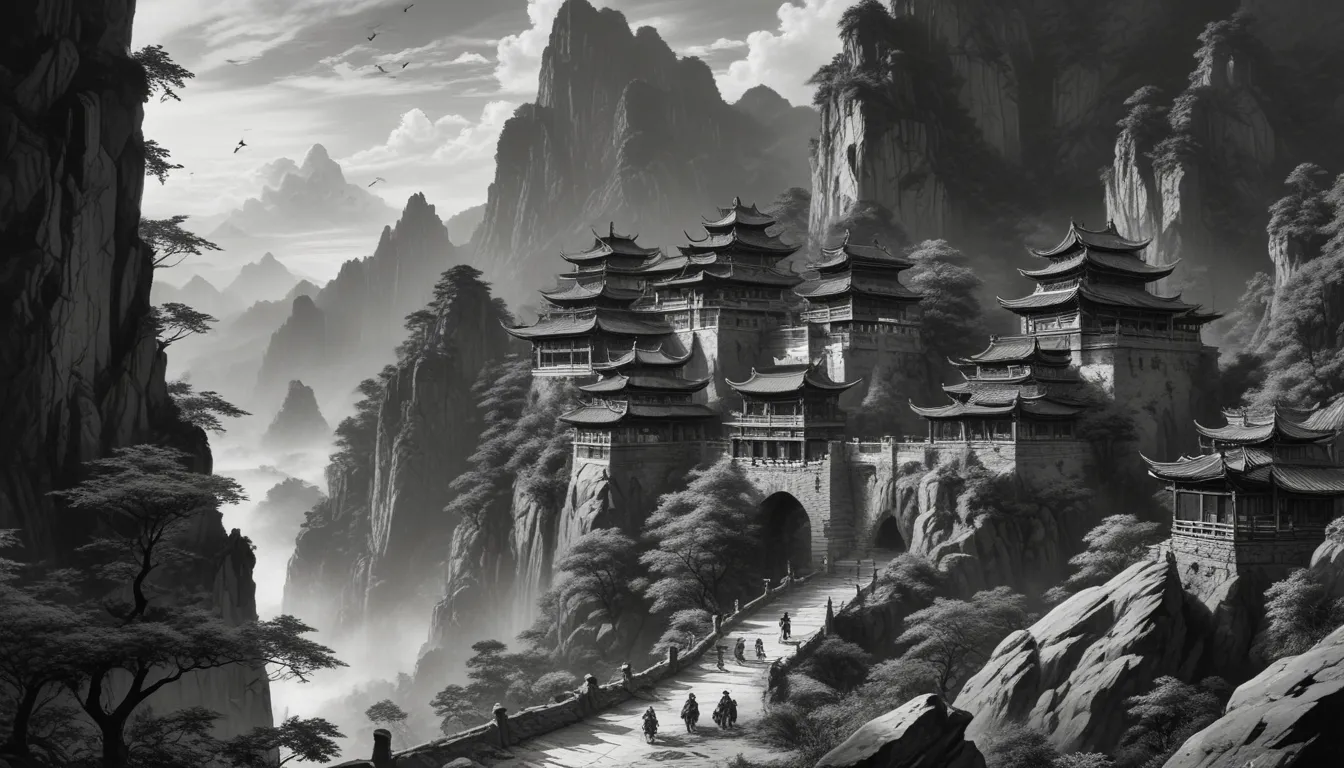The images in our articles are for illustrative purposes only and may not exactly match the content. They are intended to capture your interest and complement the text, not to replace it.
Welcome to the captivating city of Tulufan, also known as Turpan, nestled in the Xinjiang Uygur Autonomous Region of China. This hidden gem is brimming with a rich cultural tapestry, breathtaking landscapes, and a fascinating history waiting to be explored. Whether you are planning a visit to Tulufan or simply intrigued by its allure, this article will take you on a journey through 36 intriguing facts about this remarkable city.
Unveiling the Charms of Tulufan:
- Tulufan, also known as Turpan, is a city in China known for its scorching temperatures, ancient history, and delectable grapes. With a unique blend of rich culture and stunning landscapes, this city offers a travel experience like no other.
The Origins of the Name “Tulufan”:
In the Uighur language, the name “Tulufan” translates to “fertile land,” perfectly encapsulating the city’s lush landscape and abundant agricultural production.
Embracing the Heat: Tulufan’s Extreme Climate:
As one of the hottest places in China, Tulufan holds the record for the highest temperature ever recorded in the country, reaching a scorching 49.6 degrees Celsius (121.28 degrees Fahrenheit).
Exploring Low Points: Turpan Depression’s Unique Position:
Situated in the Turpan Depression, the second lowest point on Earth at 154 meters (505 feet) below sea level, Tulufan offers a glimpse into the extraordinary geographical features of the region.
The Ingenious Karez Irrigation System:
Tulufan is famous for its ancient Karez irrigation system, also known as the “underground Great Wall,” a remarkable underground water management system in use for over 2,000 years.
Tracing Silk Road Connections:
As a vital stop along the ancient Silk Road, Tulufan played a crucial role in connecting China to the West, showcasing its historical significance as a prominent trading center.
The Majestic Emin Minaret:
Home to the Emin Minaret, a UNESCO World Heritage Site, Tulufan boasts a magnificent 44-meter-tall (144 feet) tower showcasing stunning Islamic architecture dating back to the 18th century.
A Haven for Grape Enthusiasts:
Renowned for its luscious grapes and succulent raisins, Tulufan’s unique climate and fertile soil make it an ideal region for grape cultivation, offering a sweet and flavorful harvest.
Unveiling Ancient Wonders:
The city boasts the largest system of ancient underground Buddhist caves in China, with the Bezeklik Thousand Buddha Caves featuring intricate murals and sculptures dating back to the 5th century.
A Blaze of Red: The Flaming Mountains’ Refined Beauty:
Tulufan is home to the Flaming Mountains, known for their striking red color and intense heat, creating a mesmerizing landscape that captivates visitors.
Rainfall Records in China:
With the lowest annual rainfall in China at just 16 millimeters (0.63 inches), Tulufan stands out as one of the driest places in the country, showcasing its arid climate.
Silk Production Legacy:
For centuries, Tulufan has been celebrated for its exquisite silk production, highlighting the city’s skilled craftsmanship and rich tradition in the art of silk weaving.
Exploring Vast Vineyards:
Boasting the world’s oldest and largest vineyard, the Grape Valley in Tulufan spans over 1,000 acres, showcasing numerous vineyards and cementing the city’s reputation in grape cultivation.
Sweet Surprises: Turpan Watermelons’ Delightful Taste:
Turpan watermelons from Tulufan are renowned for their sweet flavor, a result of the city’s unique climate and specialized farming techniques that enhance their exceptional quality.
Embracing Natural Splendor:
From the awe-inspiring Heavenly Lake to the picturesque Tuyu Valley, Tulufan is surrounded by stunning natural wonders that offer a glimpse into the city’s breathtaking landscapes.
Melding Cultures: Tulufan’s Diverse Ethnic Tapestry:
Home to multiple ethnic groups including the Uighur, Han, Kazakh, and Hui, Tulufan’s diverse population enriches the city’s cultural vibrancy and heritage.
Harmonizing Tunes: Traditional Uighur Music’s Melodic Charms:
Tulufan is renowned for its vibrant Uighur music and dance performances, providing a cultural spectacle that showcases the region’s rich musical traditions.
Unearthing Archaeological Treasures:
The Jiaohe Ancient City near Tulufan is a remarkable archaeological site dating back over 2,000 years, offering insights into ancient Silk Road civilizations and historical marvels.
Preserving Grape Heritage: Grape Valley Museum’s Insights:
The Grape Valley Museum in Tulufan sheds light on the history and significance of grape cultivation in the region, allowing visitors to delve into the city’s agricultural legacy.
The Apricot Affair: Thriving Industry in Tulufan:
Tulufan’s flourishing apricot industry yields high-quality fruits, contributing to the city’s economy and culinary delights with a bountiful harvest.
Flavorful Feasts: Tulufan’s Culinary Delights:
With a cuisine influenced by the region’s rich cultural heritage, Tulufan offers a unique gastronomic experience featuring aromatic spices, tender meats, and a variety of delectable dishes.
Delving into History’s Depths: Tulufan’s Treasures for Enthusiasts:
For history buffs, Tulufan’s museums, historical sites, and ancient ruins provide a treasure trove of artifacts and insights into the city’s rich historical past.
Saltwater Serenity: Aydingkol Lake’s Majestic Beauty:
Aydingkol Lake, the second-largest saltwater lake in China, captivates visitors with its vast expanse covering approximately 5,000 square kilometers (1,930 square miles).
Temperature Tales: Tulufan’s Climate Contrasts:
With extreme temperature fluctuations between scorching days and cool evenings, Tulufan offers a unique climate experience that adds to its allure and charm.
Dialect Distinctions: Turpan Uighur’s Linguistic Legacy:
Tulufan’s local dialect, known as Turpan Uighur, is a variant of the Uighur language spoken by the city’s inhabitants, reflecting the region’s linguistic diversity.
Artisanal Mastery: Woodcarving and Pottery’s Intricate Crafts:
Tulufan’s artisans showcase exceptional skill in woodcarving and pottery, producing intricate designs and exquisite artwork that highlight the city’s rich artistic heritage.
Unearthing Ruins: Gaochang’s Historical Significance:
The Ruins of Gaochang, once a bustling city along the Silk Road, offer a glimpse into the region’s past as a thriving ancient civilization that flourished during ancient times.
Desert Wonders: Boundless Beauty of Sand Dunes:
Surrounded by the vast Taklamakan Desert, Tulufan offers visitors an extraordinary experience with endless stretches of sand dunes that showcase the region’s natural grandeur.
Dance Delights: Traditional Uighur Dances’ Energetic Charisma:
Tulufan’s traditional dances, such as the “Dolantige” and “Lele,” embody the vibrant and energetic culture of the Uighur people, offering a glimpse into their rich artistic traditions.
Wine Legacy: Tulufan’s Historical Winemaking Culture:
With a long history of grape and wine production, Tulufan’s vineyards have been instrumental in shaping the region’s winemaking traditions and cultural heritage.
Gateway to Adventure: Exploring Xinjiang’s Diversity from Tulufan:
As a gateway to exploring the remote and captivating Xinjiang region, Tulufan serves as an ideal starting point for travelers seeking to discover the natural wonders and cultural diversity of this unique area.
Grape Harvest Extravaganza: Tulufan’s Annual Grape Festival:
Every autumn, Tulufan celebrates its bountiful grape harvest with a lively festival, offering a vibrant showcase of the region’s cultural heritage and agricultural traditions.
Outdoor Oasis: Tulufan’s Array of Adventure Activities:
From hiking in the picturesque Tianshan Mountains to exploring ancient ruins, Tulufan provides a diverse range of outdoor activities that cater to adventure seekers and nature enthusiasts alike.
Vibrant Marketplace: Tulufan’s Bustling Bazaars’ Lively Charm:
Tulufan’s bustling bazaars are a hub of activity, filled with colorful stalls offering a wide array of local handicrafts, fresh produce, and aromatic spices that showcase the city’s vibrant marketplace culture.
Ancient Enclave: Tuyuq Village’s Timeless Appeal:
Nestled in the Tuyuq Valley, Tuyuq Village is known for its well-preserved ancient dwellings that offer visitors a glimpse into traditional Uighur village life and heritage.
Desert Gem: Crescent Moon Lake’s Tranquil Respite:
Situated amidst the vast desert, Crescent Moon Lake is a picturesque oasis in Tulufan that provides a tranquil retreat for visitors seeking a respite from the arid surroundings.
Blending Traditions: Tulufan’s Harmony of Heritage and Modernity:
With a seamless blend of ancient heritage and modern development, Tulufan offers visitors a well-rounded travel experience that combines historic charm with contemporary amenities for an unforgettable journey.
Embark on a remarkable journey through Tulufan, where breathtaking landscapes, rich cultural heritage, and fascinating insights await discovery. Whether you are drawn to its historical wonders, vibrant bazaars, or natural splendor, Tulufan promises a tapestry of experiences that will leave an indelible mark on your journey. Immerse yourself in the enchanting allure of this extraordinary city and unravel the magic of Tulufan firsthand.
FAQs: Unveiling More About Tulufan
Q: When is the best time to visit Tulufan?
A: The best time to visit Tulufan is in spring or autumn to enjoy moderate temperatures compared to the scorching summer. It’s advisable to check the weather forecast before planning your trip.
Q: How can I reach Tulufan?
A: Tulufan is accessible by air, train, and bus, with options to fly into Tulufan Airport, take a train from major Chinese cities, or hop on a bus from nearby towns to reach the city.
Q: What are the must-visit attractions in Tulufan?
A: Don’t miss exploring the ancient city of Jiaohe, the Grape Valley, the Bezeklik Thousand Buddha Caves, and the Emin Minaret, among other captivating attractions in Tulufan.
Q: Are there any traditional dishes in Tulufan worth trying?
A: Yes, Tulufan is renowned for its unique and delicious cuisine. Be sure to savor local specialties like lamb skewers, Xinjiang hand-pulled noodles, and sweet, juicy grapes during your visit.
Q: Can I experience the local culture in Tulufan?
A: Absolutely! Tulufan is home to the Uighur ethnic minority, and you can immerse yourself in their vibrant culture through traditional music, dance performances, and exploring local markets during your stay in the city.
Embark on a journey of discovery through the enchanting city of Tulufan, where ancient wonders, rich cultural heritage, and unforgettable experiences await. Explore the city’s hidden treasures, immerse yourself in its vibrant traditions, and create memories that will last a lifetime. Tulufan beckons with its allure and charm, inviting you to uncover the secrets of this cultural gem in China’s Xinjiang region.






